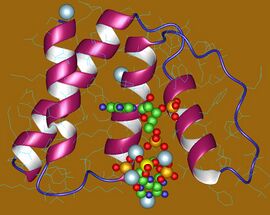Biology:Acyl-CoA-binding protein
| ACBP | |||||||||
|---|---|---|---|---|---|---|---|---|---|
 Acyl-CoA-binding protein monomer, Human | |||||||||
| Identifiers | |||||||||
| Symbol | ACBP | ||||||||
| Pfam | PF00887 | ||||||||
| InterPro | IPR000582 | ||||||||
| PROSITE | PDOC00686 | ||||||||
| SCOP2 | 1aca / SCOPe / SUPFAM | ||||||||
| OPM superfamily | 295 | ||||||||
| OPM protein | 2wh5 | ||||||||
| CDD | cd00435 | ||||||||
| Membranome | 497 | ||||||||
| |||||||||
In molecular biology, the Acyl-CoA-binding protein (ACBP) is a small (10 Kd) protein that binds medium- and long-chain acyl-CoA esters with very high affinity and may function as an intracellular carrier of acyl-CoA esters.[1] ACBP is also known as diazepam binding inhibitor (DBI) or endozepine (EP) because of its ability to displace diazepam from the benzodiazepine (BZD) recognition site located on the GABA type A receptor. It is therefore possible that this protein also acts as a neuropeptide to modulate the action of the GABA receptor.[2]
ACBP is a highly conserved protein of about 90 amino acids that is found in all four eukaryotic kingdoms, Animalia, Plantae, Fungi and Protista, and in some eubacterial species.[3]
Although ACBP occurs as a completely independent protein, intact ACB domains have been identified in a number of large, multifunctional proteins in a variety of eukaryotic species. These include large membrane-associated proteins with N-terminal ACB domains, multifunctional enzymes with both ACB and peroxisomal enoyl-CoA Delta(3), Delta(2)-enoyl-CoA isomerase domains, and proteins with both an ACB domain and ankyrin repeats.[3]
The ACB domain consists of four alpha-helices arranged in a bowl shape with a highly exposed acyl-CoA-binding site. The ligand is bound through specific interactions with residues on the protein, most notably several conserved positive charges that interact with the phosphate group on the adenosine-3'phosphate moiety, and the acyl chain is sandwiched between the hydrophobic surfaces of CoA and the protein.[4]
Other proteins containing an ACB domain include:
- Endozepine-like peptide (ELP) (gene DBIL5) from mouse.[5] ELP is a testis-specific ACBP homologue that may be involved in the energy metabolism of the mature sperm.
- MA-DBI, a transmembrane protein of unknown function which has been found in mammals. MA-DBI contains a N-terminal ACB domain.
- DRS-1,[6] a human protein of unknown function that contains a N-terminal ACB domain and a C-terminal enoyl-CoA isomerase/hydratase domain.
References
- ↑ "Molecular cloning of the gene for the yeast homolog (ACB) of diazepam binding inhibitor/endozepine/acyl-CoA-binding protein". Proc. Natl. Acad. Sci. U.S.A. 89 (23): 11287–91. December 1992. doi:10.1073/pnas.89.23.11287. PMID 1454809.
- ↑ "Diazepam binding inhibitor (DBI): a peptide with multiple biological actions". Life Sci. 49 (5): 325–44. 1991. doi:10.1016/0024-3205(91)90440-M. PMID 1649940.
- ↑ 3.0 3.1 "Evolution of the acyl-CoA binding protein (ACBP)". Biochem. J. 392 (Pt 2): 299–307. December 2005. doi:10.1042/BJ20050664. PMID 16018771.
- ↑ "Binding site differences revealed by crystal structures of Plasmodium falciparum and bovine acyl-CoA binding protein". J. Mol. Biol. 309 (1): 181–92. May 2001. doi:10.1006/jmbi.2001.4749. PMID 11491287.
- ↑ "A novel endozepine-like peptide (ELP) is exclusively expressed in male germ cells". Mol. Cell. Endocrinol. 122 (1): 69–80. August 1996. doi:10.1016/0303-7207(96)03874-9. PMID 8898349.
- ↑ "Molecular cloning and expression of a novel human cDNA related to the diazepam binding inhibitor". Biochim. Biophys. Acta 1454 (1): 126–31. May 1999. doi:10.1016/s0925-4439(99)00033-2. PMID 10354522.
 |

